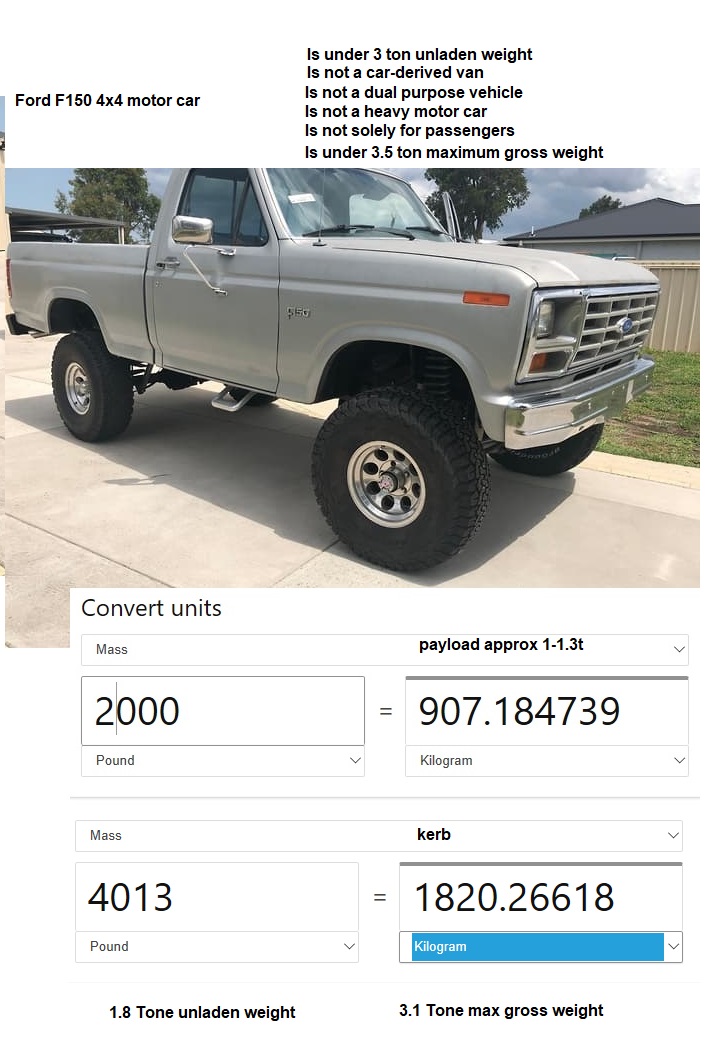|
|
Post by Administrator on Jul 19, 2019 23:20:43 GMT
The Motor Vehicles (Wearing of Seat Belts) Regulations 1993
UK Statutory Instruments1993 No. 176 PART I Regulation 3
Interpretation of references to relevant vehicles
3.—(1) In these Regulations, “relevant vehicle” means—
(a)
a passenger car,
(b)
a light goods vehicle, or
(c)
a small bus.
(2) For the purposes of this regulation—
“light goods vehicle” means a goods vehicle which—
(a)
has four or more wheels,
(b)
has a maximum design speed exceeding 25 kilometres per hour,
(c)
has a maximum laden weight not exceeding 3.5 tonnes; and
“small bus” means a motor vehicle which—
(a)
is constructed or adapted for use for the carriage of passengers and is not a goods vehicle,
(b)
has more than 8 seats in addition to the driver’s seat,
(c)
has four or more wheels,
(d)
has a maximum design speed exceeding 25 kilometres per hour;
(e)
has a maximum laden weight not exceeding 3.5 tonnes, and
(f)
is not constructed or adapted for the carriage of standing passengers.
|
|
|
|
Post by Administrator on Jul 19, 2019 23:47:35 GMT
|
|
|
|
Post by Administrator on Jul 20, 2019 17:52:41 GMT
This legislation was being put out during the period the 1990-1993 DVLC driving licence statement was being issued to over 30 million UK driving licence holders.. That a goods vehicle is not a vehicle under 3.5 tonnes. www.legislation.gov.uk/uksi/1992/3105/regulation/3/madewww.legislation.gov.uk/uksi/1993/176/regulation/3/madeThat licence must have been used in courts to (acquit) people of any speeding charges around that time. So it must be correct to the legislation... Either by The Road Traffic Regulation act 1984 section 86(6)c and Road Traffic Act 1988 section 141(a) or by merit of the above links legislation meaning that if (Adapted in any way) to carry passengers (even 2 passengers) the vehicle (if under 3.5 tones) is not a goods vehicle solely anymore, as has been adapted (or constructed) for the carriage of passengers as well. |
|
|
|
Post by Administrator on Jul 25, 2019 15:26:34 GMT
This vehicle whatever class it has been placing in, or should place in.. must be the same as the 3.5 tone light vans... How can the (Use) of this vehicle be any different to the Dual purpose vehicle? but this is over 1500kg unladen & over 2ton maximum gross weight. But the same exact use as a dual purpose vehicle. There are bigger ones.. Its still nowhere near 3 ton unladen weight allowance for a motor car. If they abolished the distinction between vehicles under & over 1500kg (30 hundred weight) then this is in fact NOT a different class to the lighter version, or to a dual purpose vehicle. The car derived van being under 2 tones maximum gross weight also is not really significant to have any different speed... a 4x4 is not even really designed for high speeds on a motorway anyway.. more for off road. So it would seem silly to have light vans designed for the road use doing 70mph on a motorway & not on a dual carriageway. Then having these which are not designed to go that fast, more for off road, with a higher speed on the road... when it really has approximately the same operating weights. It would not make sense.  |
|
|
|
Post by Administrator on Jul 16, 2021 14:14:27 GMT
I haven't addressed this topic for some time because its "archived" for when I can pursue it further. I just saw this novel toy on ebay that reminded me of a non passenger vehicle. Not adapted to carry passengers.  The situation with the weight class and speed limit of 3.5 tone vans.. is that I challenged the DVLA chief executive and they would not yield or admit error. They did not state that I was wrong. But refused to concede defeat in the matter. And act through government to correct internal government errors. It was not that long after when this pandemic hit us all and shut down half the UK. There is still a case against the Government for this. So its a matter of money 💰and as pro bona refuse to acknowledge these matters that involve hundreds of thousands of people should not be the burden if the individual or tax payer to pay for.. when its government corruption on a wide scale effecting the general public.. We are in a situation where resolution is being denied or obstructed by "the legal sector" ombudsmen and solicitors regulation authorities refuse to assist. So its a matter of money. Also its ridiculous that I should have to pay for the privilege of being the one who has to actually teach and educate let alone instruct a solicitor or QC.. So they can pursue the matter on our behalf. You have to pay £1,000s of pounds for the most expensive lawyer to sit there while you yourself teach and school them on this. Then they go off and act it to effect. Just Scandalous |
|